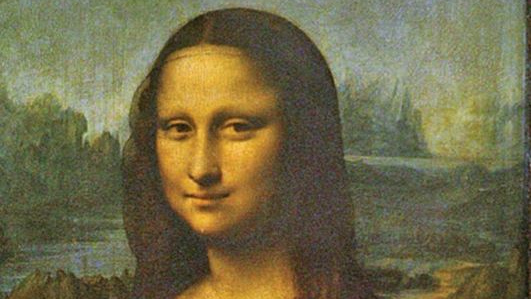7 Mysteries of the Mona Lisa

As the most famous painting in the world, the Mona Lisa draws more than six million admirers to the Louvre each year. Just what is her peculiar power?
Monda Lisa mystery #1: Who was Mona Lisa?

These days, most experts agree that the Mona Lisa is a portrait of Lisa Gherardini del Giocondo, wife of a Florentine silk merchant named Francesco del Giocondo (hence the name by which she is known in Italy and France, La Gioconda, or La Joconde). When she sat for Leonardo da Vinci, in around 1503, she was about 24 years old. Her contrapposto pose – with the body angled away from the viewer, head turned forward – was widely admired and copied by Leonardo’s contemporaries. And his sfumato technique, where sharp edges are blurred to create an uncannily lifelike effect, was seen as a brilliant technical innovation, very unlike the slightly frozen human figures of earlier, lesser painters.
Mona Lisa mystery #2: The hidden initials
In 2010, Silvano Vinceti, chairman of Italy’s National Committee for Cultural Heritage, claimed to have discerned letters minutely painted on Mona Lisa’s eyes: L and V (Leonardo da Vinci’s initials) in the right eye, and perhaps C, E or B in the left. The Louvre responded that Vinceti’s letters were simply microscopic cracks in the paint.
Mona Lisa mystery #3: The broken backdrop


The distant, dreamlike vista behind Mona Lisa’s head seems to be higher on the right-hand side than on the left. It is hard to see how the landscape would join up. This is subliminally unsettling: Mona Lisa appears taller, more erect, when one’s gaze drifts to the left than when it is on the right.
Mona Lisa mystery #4: The bewitching smile
In 2000, scientists at Harvard University suggested a neurological explanation for Mona Lisa’s elusive smile. When a viewer looks at her eyes, the mouth is in peripheral vision, which sees in black and white. This accentuates the shadows at the corners of her mouth, making the smile seem broader. But the smile diminishes when you look straight at it. It is the variability of her smile, the fact that it changes when you look away from it, that makes her seem so alive, so mysterious.
Mona Lisa mystery #5: The unknown bridge
The Mona Lisa’s background landscape seems unreal, but the bridge might be one that Leonardo knew. It is usually said to be Ponte Buriano in Tuscany, but in 2011, a researcher claimed it depicts the Bobbio Bridge over the Trebbia, which was washed away in a flood in 1472.
Mona Lisa mystery #6: Da Vinci’s obsession
Leonardo da Vinci worked on the painting for four years, and possibly at intervals after that. He always took it with him when he travelled, and he never signed or dated it. The picture went with him when, towards the end of his life, he moved to France.
It was sold to his last patron, King François I, and remained out of sight in the royal collection for almost 200 years. In 1799 Napoleon came across the painting and commandeered it for his bedroom. Only in 1804 did the Mona Lisa go on public display – in the newly founded Louvre Museum.
At that time, it was not seen as particularly interesting, but in the middle of the 19th century Leonardo’s stock as an artist slowly rose. He came to be seen as the equal of the two acknowledged Renaissance greats, Michelangelo and Raphael. This new interest in Leonardo as a painter drew attention to his few known works.
Mona Lisa mystery #7: Was Mona Lisa unwell?
Mona Lisa has often been scrutinised by medical experts. In 2010, an Italian doctor looked at the swelling around her eyes and diagnosed excess cholesterol in her diet. Other conditions ascribed to her include facial paralysis, deafness, even syphilis.
More happily, it has been suggested that the look of contentment on her face indicates she is pregnant. Dentists have also posited bruxism, compulsive grinding of the teeth; or that the line of her top lip suggests that her front teeth are missing – which, along with the faintest hint of a scar on her lip, raises the possibility that she was a victim of domestic violence.
Jungians have seen her as an accomplished representation of the anima, the female archetype that resides in each one of us. It seems that almost any condition can be read into that puzzling face.
From Great Secrets of History © 2012. The Reader’s Digest Association, inc.
This article originally appeared on Reader’s Digest
Images: Reader’s Digest
